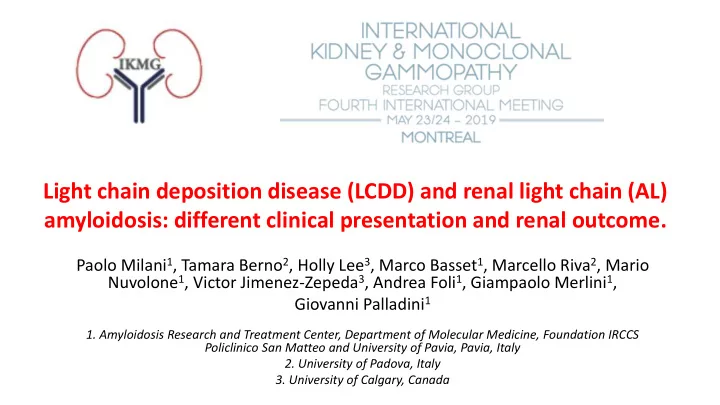

Light chain deposition disease (LCDD) and renal light chain (AL) amyloidosis: different clinical presentation and renal outcome. Paolo Milani 1 , Tamara Berno 2 , Holly Lee 3 , Marco Basset 1 , Marcello Riva 2 , Mario Nuvolone 1 , Victor Jimenez-Zepeda 3 , Andrea Foli 1 , Giampaolo Merlini 1 , Giovanni Palladini 1 1. Amyloidosis Research and Treatment Center, Department of Molecular Medicine, Foundation IRCCS Policlinico San Matteo and University of Pavia, Pavia, Italy 2. University of Padova, Italy 3. University of Calgary, Canada
Disclosure of Conflict of Interest ❑ I have a relationship with a for-profit and/or a not-for-profit organization to disclose Name of for-profit or not-for-profit Description of relationship(s) Nature of relationship(s) organization(s) Janssen, Pfizer Honoraria Any direct financial payments including receipt of honoraria Membership on advisory boards or speakers’ bureaus Funded grants or clinical trials Patents on a drug, product or device All other investments or relationships that could be seen by a reasonable, well- informed participant as having the potential to influence the content of the educational activity
Introduction Light chain deposition disease, LCDD Publications with LCDD patients: Pozzi et al. AJKD 2003 Sayed et al. Blood 2015 Kourelis et al. AJH 2016 Mohan et al. AJH 2016 Bridoux et al, Kidney Internat 2015
Introduction Light chain (AL) amyloidosis 82% 66% 17% 14% 12% 9% Data from 1065 patients with AL amyloidosis from the Pavia database Stage I: both proteinuria 5g/24h and eGFR 50 mL/min per 1.73 m 2 Stage II: either proteinuria >5g/24h or eGFR <50 mL/min per 1.73 m 2 Stage III: both proteinuria >5g/24h and eGFR <50 mL/min per 1.73 m 2 Palladini et al. Blood 2014
Methods • We compare two consecutive series of LCDD and renal AL amyloidosis. • Renal survival was defined as the time from diagnosis to dialysis initiation. 74 patients with LCDD: 207 patients with AL amyloidosis from the • 61 from the Pavia Amyloid Center Pavia Amyloidosis Center • 8 from the Padova Hospital • 5 from the Calgary Hospital All patients had a biopsy proven diagnosis of AL amyloidosis All patients had a biopsy proven diagnosis of LCDD and are treated and followed at the Only patients with Mayo2004 cardiac stage I referral center. (NT-proBNP <332 ng/L & cTnI< 0.1 ng/mL) were included in the study.
Results: patients characteristics’ Variables P LCDD (N=74) AL amyloidosis (N=207) Age at diagnosis, median 56 (46-61) 62 (54-69) <0.001 Sex, male 43 (58) 112 (54) 0.278 eGFR, median 32 (19-51) 70 (49-88) <0.001 CKD stage 1 (eGFR>90) 5 (7) 46 (22) <0.001 CKD stage 2 (eGFR: 60-89) 6 (8) 83 (40) <0.001 CKD stage 3 (eGFR: 30-59) 24 (32) 51 (25) 0.126 eGFR, P<0.001 Proteinuria, P<0.001 CKD stage 4 (eGFR 15-29) 23 (31) 20 (9) <0.001 160 25 140 CKD stage 5 (eGFR <15) 8 (11) 8 (3) 0.028 20 120 Dialysis at diagnosis 8 (11) 2 (1) <0.001 100 Proteinuria, median 2.6 (0.7-5.7) 6.2 (3.5-9.9) <0.001 15 80 Nephrotic range proteinuria 29 (39) 159 (77) <0.001 10 60 40 5 20 0 0 eGFR, mL/min eGFR, mL/min Proteinuria, g/24h Proteinuria, g/24h LCDD (N=74) AL (N=207) LCDD (N=74) AL (N=207)
Results: patients characteristics’ Variables LCDD (N=74) AL amyloidosis (N=207) P Kappa:lambda LC type 63 (85): 11 (15) 48 (23) : 157 (76) <0.001 dFLC, mg/L 190 (44-668) 75 (25-263) <0.001 iFLC, mg/L 257 (72-703) 91 (44-290) <0.001 BMPC %, median 10 (6-15) 10 (6-14) 0.210 dFLC, P<0.001 4000 BMPC, P=0.210 60 3500 50 3000 2500 40 2000 30 1500 1000 20 500 10 0 0 -500 BMPC, % BMPC, % dFLC, mg/L dFLC, mg/L LCDD (N=74) AL (N=207) LCDD (N=74) AL (N=207)
Results: renal survival 100 32/74 (43%) patients with LCDD 80 required dialysis. LCDD, median 9 years 5 patients received renal transplant 60 P<0.001 40 42/207 (19%) patients with AL required dialysis. 20 AL amyloidosis, median not reached 10 patients received renal transplant 0 0 24 48 72 96 120 144 168 Time (months)
Significant predictors of renal outcome at univariate analysis Light chain (AL) amyloidosis Light chain deposition disease, LCDD Variable HR (95% CI) P Variable HR (95% CI) P eGFR 0.95 (0.93-0.98) 0.001 eGFR 0.95 (0.93-0.96) <0.001 Proteinuria 1.10 (1.04-1.16) <0.001 Proteinuria 1.03 (0.94-1.13) 0.418 eGFR <30 mL/min P<0.001 P<0.001 P=0.001 eGFR >30 mL/min Stage I: both proteinuria 5g/24h and eGFR 50 mL/min per 1.73 m 2 Stage II: either proteinuria >5g/24h or eGFR <50 mL/min per 1.73 m 2 Stage III: both proteinuria >5g/24h and eGFR <50 mL/min per 1.73 m 2
Results: response to therapy in LCDD Type of therapy, 1° line N (%) Response to 1° line N (%) Bortezomib 34 (46) Overall Hem Response 25 (34) Oral melphalan 19 (27) CR / VGPR / PR 18 (24) / 3 (4) / 4 (6) High dose DEX 12 (16) Thalidomide 4 (5) Less than VGPR, median 5 years Bendamustine/rituximab 1 (1) ASCT, yes 1 (1) Other 3 (4) Autologous stem cell transplant, ASCT: 4 patients P <0.001 Median n. of lines of therapy: 2 (range: 2-5) CR/VGPR Second or subsequent therapies: Lenalidomide, Pomalidomide, Daratumumab.
Conclusions • The clinical presentation and outcome of LCDD and renal AL amyloidosis are different; • LCDD is characterized by a more advanced renal dysfunction, less pronounced proteinuria and faster progression to dialysis; • Achievement of CR/VGPR after first line therapy according to ISA criteria is associated with a significant decrease in progression to dialysis (0 vs. 45% in 4 years).
Acknowledgements Pavia Amyloidosis Research and Treatment Center: Marco Basset, Mario Nuvolone, Francesca Lavatelli, Roberta Mussinelli, Stefano Perlini, Andrea Foli, Giampaolo Merlini, Giovanni Palladini Padova University Hospital: Tamara Berno, Marcello Riva . Calgary university Hospital: Holly Lee, Victor Jimenez-Zepeda
Recommend
More recommend